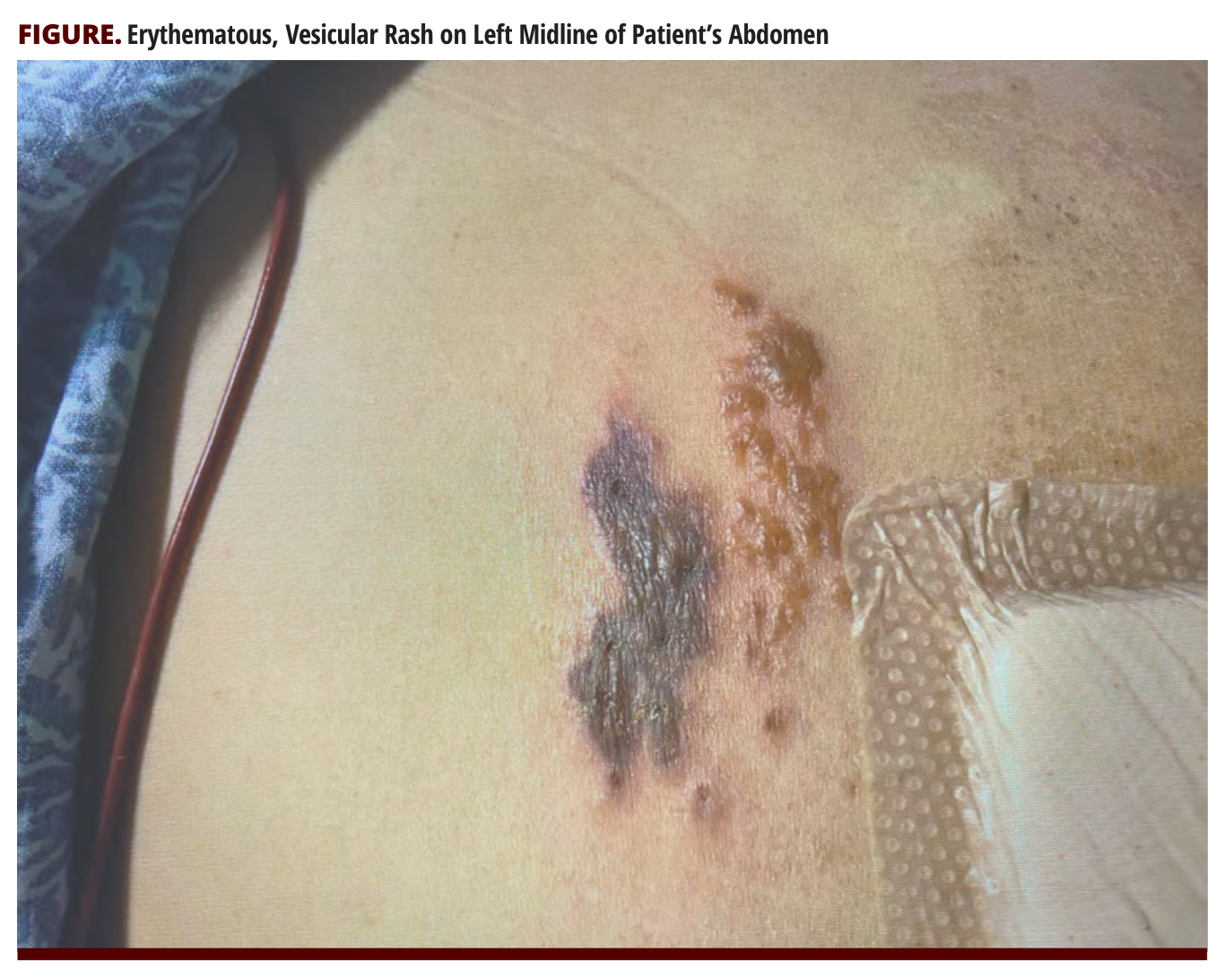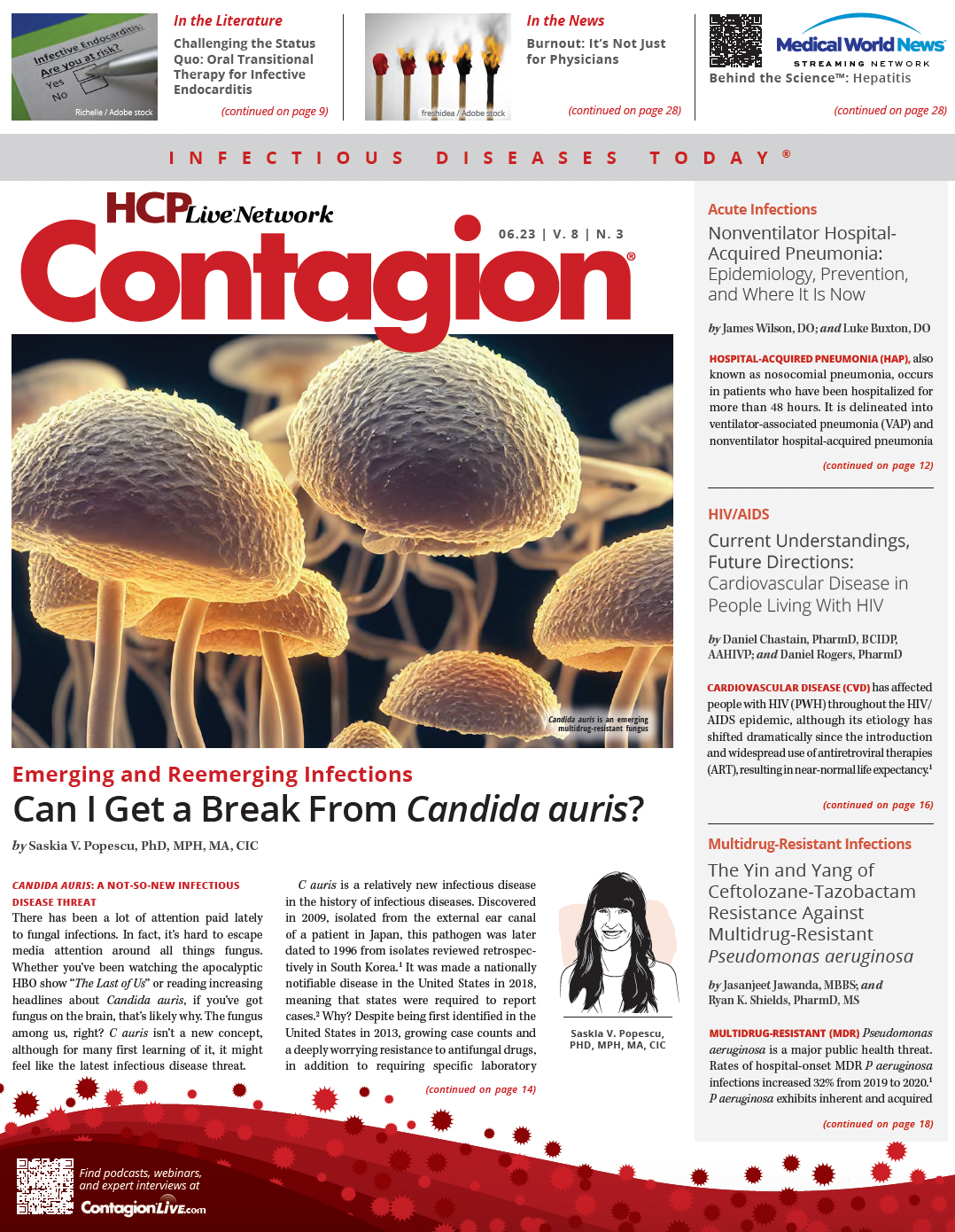A Case of Varicella-Zoster Meningitis Causing Postoperative Fevers After Umbilical Hernia Repair
Due to worsening headaches and unrevealing cross-sectional imaging and ascites fluid analyses, this patient's differential evolved toward a central nervous system source.
FINAL DIAGNOSIS
Varicella-zoster meningitis
HISTORY OF THE PRESENT ILLNESS
A 44-year-old man presented as a transfer from an outside hospital for surgical consultation for an umbilical hernia. The hernia had been present for several months and increasing in size for 1 week prior to admission. On the day of admission, the patient was shopping, and a store employee noticed pink fluid on his shirt. The patient presented to the hospital, where it was noted that his umbilical hernia had eroded through his skin, resulting in leakage of ascites (“Flood syndrome”).
A colostomy bag was placed over the opening. The fluid output did not decrease over 1 week, so he was transferred to our institution for surgical consultation.
MEDICAL HISTORY
The patient’s medical history included the following: decompensated cirrhosis secondary to alcohol use and hepatitis C that was complicated by refractory ascites, spontaneous bacterial peritonitis, hepatic encephalopathy, and esophageal varices; listed for liver transplant; treated hepatitis C with sustained virologic response; bipolar disorder; posttraumatic stress disorder; and alcohol use disorder.
KEY MEDICATIONS
Escitalopram, furosemide, lactulose, midodrine, pantoprazole, sodium zirconium cyclosilicate, spironolactone
EPIDEMIOLOGICAL HISTORY
The patient’s social history was significant for alcohol use disorder. He reported drinking 750 mL of vodka daily from aged 16 years until 1.5 months prior to hospital admission. He smoked a quarter pack of cigarettes daily and had a remote history of intranasal cocaine use. He had multiple tattoos. He lived in the Philadelphia, Pennsylvania, area for 15 years prior to admission and resided in a house with his cousin. His family history was significant for alcohol use disorder and cirrhosis in both parents.
PHYSICAL EXAMINATION
At the time of evaluation by the infectious disease service, the patient was febrile to 101.9 °F. His blood pressure was 112/64 mm Hg, and he was saturating at 99% on room air. He appeared uncomfortable, although he was not in acute distress.
His abdominal exam was notable for tenderness around a midline incision without drainage or erythema. A skin exam revealed a vesicular rash near the midline of his abdomen (FIGURE).

STUDIES
At the time of evaluation by the infectious disease service, the patient’s labs were notable for a normal white blood cell (WBC) count of 5.1 K/mm3 (reference range [RR], 4.0-11.0 K/mm3), a low hemoglobin level of 9.1 g/dL (RR, 14.0-17.5 g/ dL), and thrombocytopenia with a platelet count of 83 K/mm3 (RR, 150-450 K/mm3). His hepatic function panel was notable for an elevated total bilirubin level of 2.4 mg/dL (RR, 0.0-1.0 mg/dL), an elevated direct bilirubin level of 1.1 mg/dL (RR, 0.0-0.6 mg/dL), and a low total protein level of 5.7 g/dL (RR, 6.4-8.2 g/dL).
CLINICAL COURSE
The patient underwent umbilical hernia repair on hospital day 2. A 4 x 4-cm fascial defect was noted in the operating room. On hospital day 7 (postoperative day 5), he developed a temperature of 101.9 °F, as well as significant pain along his incision, bilateral leg swelling, and a dry cough. A paracentesis was completed and was not consistent with bacterial peritonitis.
A CT scan of the abdomen and pelvis revealed no concern for abscess or infection. The infectious disease service was then consulted, and his prophylactic ceftriaxone was broadened to piperacillin and tazobactam. He was noted to have a vesicular rash near his umbilicus, which was thought to be a reaction to the surgical tape and dressings in that area. His fevers continued without a clear source, reaching a temperature as high as 102.6 °F.
On hospital day 10 (postoperative day 8), he developed a new headache in the frontal area. He reported a history of migraines but had not experienced one in several years. Additionally, his rash had expanded and was presumed to be localized zoster of his abdomen, so he was started on intravenous acyclovir. On hospital day 11 (postoperative day 9), a new cluster of vesicles appeared on his left flank, as well as several scattered individual vesicles on his arms and legs. His headache worsened, with associated retro-orbital pain and nausea.
A lumbar puncture was recommended, and he was moved into airborne isolation for disseminated herpes zoster. The cerebrospinal fluid (CSF) studies were consistent with a viral meningitis, showing an elevated WBC count with lymphocyte predominance, elevated protein levels, and a slightly low glucose level. Polymerase chain reaction (PCR) testing for varicella-zoster virus (VZV) was positive, with a viral load greater than 400,000 copies. Intravenous acyclovir was continued, and the patient slowly showed clinical improvement, with resolution of fevers and headache.
DIAGNOSTIC PROCEDURES AND RESULTS
Paracentesis was performed during hospitalization, with 1.75 L of clear, yellow ascites removed. Analysis revealed a WBC count of 163/mm3 and a red blood cell (RBC) count of 3300/mm3. An aerobic body fluid smear and culture revealed few WBCs with no organisms seen and no organism growth. A lumbar puncture was performed with opening pressure of 12 cm H2O.
Eleven milliliters of faintly yellow, clear CSF was removed. CSF analysis revealed a WBC count of 805/mm3 (RR, 0-5 mm3). RBC count was 238/mm3 (RR, 0-10 mm3). Differential included 1% neutrophils, 69% lymphocytes, 25% monocytes, and 5% macrophages. The patient’s CSF protein level was elevated to 221 mg/dL (RR, 15-40 mg/dL), and his CSF glucose level was low at 39 mg/dL (RR, 40-70 mg/dL).
CSF culture and smear showed few WBCs, no organisms, and no growth at 5 days. A CSF acid-fast bacilli smear was negative, and a culture showed no growth at 6 weeks. CSF cryptococcal antigen was negative. CSF fungal culture showed no growth at 2 weeks. CSF herpes simplex virus type 1 and herpes simplex virus type 2 were not detected by PCR testing. PCR testing of CSF VZV showed a viral load of 404,947 copies/mL.
TREATMENT AND FOLLOW-UP
The patient was discharged from the hospital after a 19-day admission and completed a 14-day course of intravenous acyclovir.
DISCUSSION
We present a case of VZV meningitis that occurred postoperatively, causing persistent fevers and headache. Although this patient’s clinical manifestations were relatively typical, his timeline for infection was unusual, resulting in a unique cause of postoperative fevers.
Postoperative fevers are common, with an estimated prevalence of 14% to 91%.1 The differential for postoperative fevers is largely based on timeline from surgery. Fevers within 48 hours after surgery are typically noninfectious, with the most common cause being cytokine release.1
Fevers that occur more than 48 hours after surgery are more likely to be infectious in nature. The most common infectious etiologies for postoperative fever include urinary tract infections, surgical-site infections, pneumonia, catheter-associated bloodstream infections, and Clostridioides difficile.1
Just like our patient, individuals with cirrhosis face higher rates of complications after umbilical hernia repair, including hernia recurrence, wound infection, and peritonitis, related to higher intra-abdominal pressure caused by ascites.2,3 One study found that patients with cirrhosis are 8 times more likely to die within 90 days postoperatively vs those without cirrhosis (odds ratio, 8.50; 95% CI, 1.91-37.86).2
Our patient’s fevers started on postoperative day 5 and were also associated with incisional-site pain. Given this, the initial work-up and empiric treatment focused on surgical-site and intra-abdominal infections. However, due to worsening headaches and unrevealing cross-sectional imaging and ascites fluid analyses, the patient’s differential evolved toward a central nervous system (CNS) source.
VZV infection has been shown to cause a variety of CNS manifestations, including meningitis, encephalitis, vasculopathy, and myelopathy.4 VZV meningitis or encephalitis can occur as either a primary infection or reactivation and with or without cutaneous involvement.5 CNS infection is typically associated with being older than 50 years and immunocompromised.5
Although VZV reactivation is relatively common in the posttransplant patient, reported postoperative cases outside this population are very rare.6 One recent case report describes VZV reactivation in a healthy 67-year-old woman who underwent left total knee arthroplasty, resulting in shingles in the left L2 to L3 dermatomal distribution.7
Correlations between trauma and zoster reactivation have been studied for decades; Juel-Jensen noted a history of trauma as a precipitating factor in the development of shingles in an article published in 1970.8 It has been hypothesized that reactivation may be due to direct neuronal manipulation, as well as to the overall stress of surgery itself.9,10
This case offers a unique scenario of postoperative VZV reactivation following umbilical hernia repair. Additionally, due to a history of decompensated cirrhosis, this patient was predisposed to the development of CNS manifestation. Given this rare combination of factors, this case aims to present a postoperative development of VZV meningitis to highlight the wide spectrum of clinical presentations possible for this viral illness.
References
1. Pile JC. Evaluating postoperative fever: a focused approach. Cleve Clin J Med. 2006;73(suppl 1):S62-S66. doi:10.3949/ccjm.73.suppl_1.s62
2. Snitkjær C, Jensen KK, Henriksen NA, et al. Umbilical hernia repair in patients with cirrhosis: systematic review of mortality and complications. Hernia. 2022;26(6):1435-1445. doi:10.1007/s10029-022-02598-7
3. Coelho JC, Claus CM, Campos AC, Costa MA, Blum C. Umbilical hernia in patients with liver cirrhosis: a surgical challenge. World J Gastrointest Surg. 2016;8(7):476-482. doi:10.4240/wjgs.v8.i7.476
4. Nagel MA, Niemeyer CS, Bubak AN. Central nervous system infections produced by varicella zoster virus. Curr Opin Infect Dis. 2020;33(3):273-278. doi:10.1097/QCO.0000000000000647
5. Alvarez JC, Alvarez J, Tinoco J, et al. Varicella-zoster virus meningitis and encephalitis: an understated cause of central nervous system infections. Cureus. 2020;12(11):e11583. doi:10.7759/cureus.11583
6. Pergam SA, Limaye AP; AST Infectious Diseases Community of Practice. Varicella zoster virus in solid organ transplantation: guidelines from the American Society of Transplantation Infectious Diseases Community of Practice. Clin Transplant. 2019;33(9):e13622. doi:10.1111/ctr.13622
7. Jain M, Tripathy PR, Mohanty CR. Post-total knee arthroplasty herpes zoster activation. BMJ Case Rep. 2019;12(4):e228639. doi:10.1136/bcr-2018-228639
8. Juel-Jensen BE. The natural history of shingles. events associated with reactivation of varicella-zoster virus. J R Coll Gen Pract. 1970;20(101):323-327.
9. Park KS, Yoon TR, Kim SK, Park HW, Song EK. Acute postoperative herpes zoster with a sciatic nerve distribution after total joint arthroplasty of the ipsilateral hip and contralateral knee. J Arthroplasty. 2010;25(3):497.e11-497.e15. doi:10.1016/j.arth.2008.10.007
10. Massad MG, Navarro RA, Rubeiz H, et al. Acute postoperative shingles after thoracic sympathectomy for hyperhidrosis. Ann Thorac Surg. 2004;78(6):2159-2161. doi:10.1016/S0003-4975(03)01499-1

Newsletter
Stay ahead of emerging infectious disease threats with expert insights and breaking research. Subscribe now to get updates delivered straight to your inbox.
